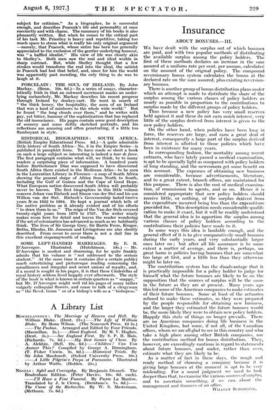Insurance
ABOUT BONUSES.—III.
WE have dealt with the surplus out of which bonuses are paid, and with two popular methods of distributing the available surplus among the policy holders. The first of these methods declares an increase in the sum assured at a uniform rate per cent. per annum, calculated on the amount of the original policy. The compound reversionary bonus system calculates the bonus at the declared rate on the sum assured, plus existing reversion- ary bonuses.
There is another group of bonus distribution plans under which an attempt is made to distribute the share of the surplus among the various classes of policy holders as nearly as possible in proportion to the contributions to surplus made.by the different groups of policy holders. Thus because a new policy has very Small reserves held against it and these do not earn much interest, very little of the surplus derived from interest is given to the new policy holders.
On the other hand, when policies have been long in force, the reserves are large, and earn a great deal of interest, consequently a large part of the surplus derived- from interest is allotted to those policies which have been in existence for many years. In corresponding fashion, the mortality among recent entrants, who have lately passed a medical examination, is apt to be specially light as compared with policy holders of long standing, and the newcomers get some benefit on this account. The expenses of obtaining new business are considerable, because advertisements, literature,' and to a great extent, branch offices, are maintained for this purpose. There is also the cost of medical examina- tion, of commission to agents, and so on. Hence it is considered appropriate that new policy holders should receive little, or nothing, of the surplus derived from the expenditure incurred being less than the expenditure provided for. This description needs considerable qualifi:- cation to make it exact, but it will be readily understood that the general idea is to apportion the surplus among various classes of policy holders according to the contributions their policies have made to it. , In some ways this idea is laudable enough, and the general effect of it is to give comparatively small bonuses during the early years, and very substantially larger ones later on ; but after all life assurance is to some extent a matter of average, and there is, perhaps, no great harm in policies having bonuses- that are somewhat too large at first, and a little less than they otherwise might be later on.
The contribution system has the disadvantage that it is practically impossible for a policy holder- to judge for himself what the future bonuses are likely to be on the supposition. that the they of surplus will be the same in the future as they are at present. Many years ago this led some of the American companies to make estimates of their future bonuses. Some at least of the actuaries refused to make these estimates, so they were prepared by the people responsible for obtaining new business, and the larger they estimated the future bonuses would- be, the more likely they were to obtain new policy holders. .
Happily this state of things no longer prevails. There are no American companies doing life business in the United Kingdom, but some, if not all, of the Canadian offices, whom we are all glad-to see in this country and who take a high place among other British companies, use the contribution method for bonus distribution. They, however, are exceedingly cautious in regard to statements about future bonuses, and under, rather than over, estimate what they are likely to be. As a matter of fact in these days, the rough and ready method of -Choosing a coin-piny because it is giving large bOnuses at the moment is apt to be very misleading. For a sound judgment we need to look deeper than that, to examine the various sources of-surplus, and to ascertain something, if we can, about • the management and finances of an office.
WILLL4\I SCII0OLINP.






































 Previous page
Previous page